Comparing the effects of blended learning and traditional instruction on “Medical Genetics and Embryonic Development” in undergraduate medical students: a randomized controlled trial
-
Bing Liao
, Shuangyu Ma
Abstract
Objectives
The Shanghai Jiao Tong University School of Medicine is at the forefront of educational innovation to enhance student learning outcomes. Herein, this study aims to evaluate the effectiveness of blended learning compared to traditional on-site instruction in the “Medical Genetics and Embryonic Development” curriculum.
Methods
A randomized trial was conducted involving 338 second-year clinical medicine students during the 2023–2024 academic year. The students were divided into two groups: one received blended learning and the other, on-site instruction. Students’ performance was evaluated using ongoing assessments together with mid-term and final exams.
Results
Blended learning led to higher overall final grades, with no significant difference in quiz performance, but better exam scores compared to traditional learning. At the level of higher-order learning skills, students in the blended learning group performed better in karyotyping. However, the traditional on-site group slightly outperformed the blended learning group in case-based learning scores. Ultimately, approximately 92 % of students were satisfied with the blended learning course.
Conclusions
Blended learning does show promise in improving the self-learning skill and overall learning outcomes of medical students. Future studies should focus on optimizing blended learning strategies and assessing their long-term impacts on clinical competencies.
Introduction
To foster the development of elite clinicians with comprehensive analytical and problem-solving capabilities, the Shanghai Jiao Tong University School of Medicine initiated a multidisciplinary integrated teaching reform in 2009. This reform has resulted in the creation of eight new courses that build upon traditional foundational courses, including the “Medical Genetics and Embryonic Development” integrated course. This course comprises medical genetics, early embryonic development, and partial content of molecular biology, with the aim of providing a theoretical basis for the diagnosis, treatment, and prevention of genetic diseases. Thus, this course is an important one that spans both basic medical science and clinical medicine.
Interdisciplinary integration, characterized by high logical demands and a multitude of complex and diverse knowledge points, poses a challenge to student comprehension. Meanwhile, the large number of courses and the heavy academic workload lead to undergraduate students feeling a great deal of pressure and difficulty in their studies and even generating passive motivation for basic medical course learning. Enhancing students’ self-learning abilities presents a significant challenge for instructors, particularly in the context of this course.
By engaging in an integrated course through traditional on-site learning methods, undergraduate medical students can acquire foundational knowledge of early embryonic development, the core principles of medical genetics, and the genetic underpinnings and transmission patterns of genetic disorders. This enables them to fulfill the knowledge and skill objectives established by the course curriculum. However, there is still a considerable gap in the evaluation criteria (higher-order, innovativeness, and challenge) proposed by Ministry of Education. To meet this need, innovative teaching models can be integrated into the course. Among these, blended learning stands out as a promising alternative, which is defined as the strategic combination of face-to-face instruction and online learning 1], [2], [3. Blended learning can be useful and effective in medical education 4], [5], [6, and has been reported to play a positive role in enhancing self-learning capability and deep thinking in medical education courses 7], [8], [9. In addition, blended learning methods contribute to knowledge acquisition in health sciences [10]. Although multiple studies have reported the benefits of using blended learning, there is still little empirical evidence regarding its relative effectiveness compared with the traditional learning approach in “Medical Genetics and Embryonic Development”. Here, we conducted a study implementing online learning together with on-site learning to further assess the potential value of blended learning in this course. This study aims to compare the effectiveness of blended learning vs. traditional on-site learning in improving student outcomes in the “Medical Genetics and Embryonic Development” course.
Methods
Study subjects
The study sample comprised 338 second-year undergraduate students majoring in clinical medicine from the Class of 2022 at Shanghai Jiao Tong University School of Medicine, China, who were enrolled in the “Medical Genetics and Embryonic Development” course between September 2023 and January 2024. Two methods of education delivery were tested: blended learning and traditional on-site learning. The students were divided into two groups: 159 and 179 students were taught separately using blended and traditional on-site learning methods, respectively. The grouping was performed by class, and the selection of classes was performed randomly. Notably, both teaching modes were carried out simultaneously.
To implement blended learning, we integrated online teaching methods into traditional on-site learning for the students of Class 2022 in the fall of 2023, mainly by posting online video lectures and adding a post-lecture quiz. In parallel, a post-lecture quiz was engaged in traditional on-site courses, and video lectures were available for students in the on-site group. The learning objectives, course materials, and course syllabi were identical for the blended and traditional on-site courses. The blended learning approach was supported by multimedia didactic materials, which can be accessed by the students via the internet using the ChaoXing platform. Meanwhile, online students also had the option of posting questions through a web portal for discussion with students and teachers. These documents contained the same information as those utilized in the on-site courses. Students were provided with reference literature to complement the lecture as well as course lecture slides. In addition to formal lectures, both blended and on-site courses include case-based learning (CBL) as well as live group activities. The total class hours were 54 h, and the duration of each class was 40 min. In the blended group, 28 % of class hours were assigned for online learning, and 72 % of class hours were assigned for on-site learning.
The formal assessment of student performance was uniform across both teaching methodologies, and encompassed the following:
Ongoing assessment: It consisted of post-lecture quizzes, CBL performance, and karyotyping;
Mid-term exam and final exam: The exam papers were constructed by the course instructors and consisted of single-choice items, definitions of terms, karyotype descriptions, and answer questions.
The specific process of the blended learning model is shown in Table 1.
The process of the blended learning model.
| Blended learning model | ||
|---|---|---|
| Pre-lecture | Build online teaching platform | Online teaching platform: ChaoXing |
| Upload teaching resources | Learning materials: assigned reading, instructor-prepared lecture videos, PowerPoint slides, genetic disease related videos, audio files, and science stories | |
| In-lecture | Online: self-learning | Online: study the learning materials and discuss with students and teachers |
| Offline: lecture | Offline: lecture by teachers and group discussion | |
| Case-based learning (CBL) | CBL: group discussion and student presentation | |
| Post-lecture | Quizzes and exams (mid-term and final) | Quizzes: single choice question |
| Karyotyping | Exams: single choice question, terminology explanation, karyotype analysis, and short answer question | |
| Mentoring | Karyotyping: online software | |
| Questionnaire | Mentoring: posting questions or private chat with teachers online or offline | |
| Questionnaire: student satisfaction assessment | ||
Statistical analysis
All statistical analyses were conducted using the GraphPad Prism software. Comparisons of the final and ongoing assessment scores between different groups were conducted using a Mann–Whitney U test, a nonparametric method to compare the differences between two groups without assuming normal distribution. Data are presented as mean±SD, and p<0.05 was considered statistically significant: *p<0.05, **p<0.01, ***p<0.001, ****p<0.0001.
Results
Students’ mid-term and final examination scores, and overall final scores
Among the 338 medical students, 159 (47 %) were allocated to the blended learning group, which included 42 % female participants. In parallel, the on-site traditional method was introduced to 179 medical students, of whom 50 % were female. All participants completed their scheduled coursework within the expected time frame. The majority of students passed the final exam, while one student failed in the blended learning group, and three students failed in the on-site group. To evaluate the comparative effectiveness of the two educational approaches, we conducted a Mann–Whitney U test analysis of students’ mid-term and final examination scores. The result shows that the blended learning group scored higher than the traditional on-site group in the mid-term examination [(71.16±16.45) in the blended learning group, and (64.97±17.27) in the on-site learning group] (Figure 1A) as well as in the final examination [(71.97±11.82) in the blended learning group, and (69.66±11.78) in the on-site learning group] (Figure 1B). However, there were no statistically significant differences in the final examination scores between the two groups (Figure 1B). Further analysis of the distribution of the final examination scores in different score sections revealed that the average final examination scores were comparable between the two groups (Figure 1C). Nonetheless, the percentages of students in the “excellent” (≥90, 1.89 % vs. 0.56 %), “very good” (80–89, 23.90 % vs. 21.23 %), and “good” (70–79, 36.48 % vs. 32.96 %) sections were higher in the blended learning group than those in the on-site group (Figure 1D). In contrast, the percentages of students who were in the “satisfactory” (60–69, 23.27 % vs. 25.70 %) and “failed” (≤59, 14.47 % vs. 19.55 %) sections were higher in the on-site group than those in the blended learning group (Figure 1D).
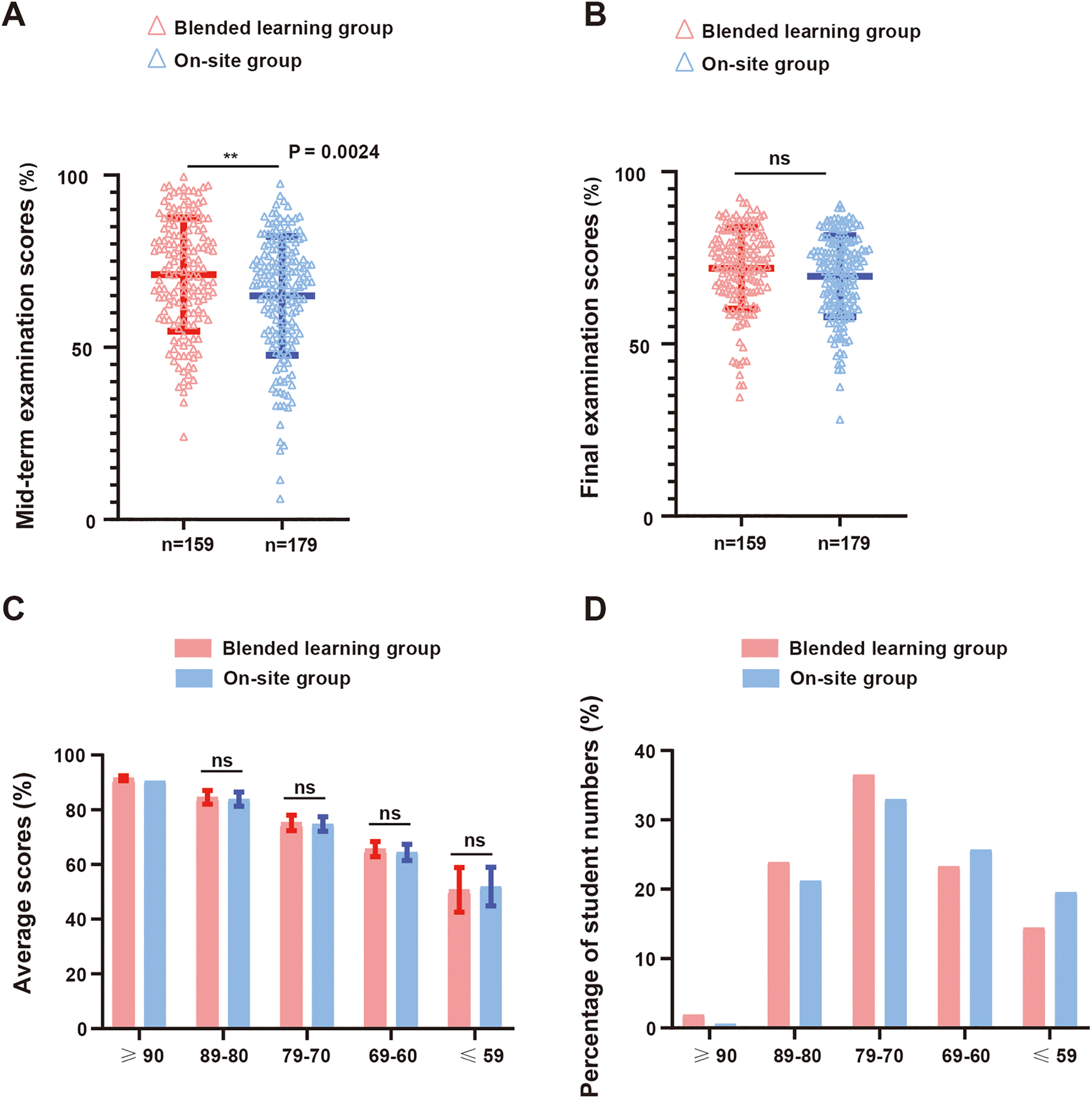
Difference and distribution of students’ mid-term and final examination scores in the two teaching groups. (A) Dot plot of students’ mid-term examination scores. (B) Dot plot of the students’ final examination scores. (C and D) Bar chart of students’ average scores on the final examination categorized by score range (C) and student percentages grouped by final examination score intervals (D). Excellent, ≥90; very good, 80–89; good, 70–79; satisfactory, 60–69; failed, ≤59.
Compared to the mid-term and final examination scores, the overall final score, calculated as the primary outcome measure in this study, provides a more comprehensive evaluation criterion for teaching effectiveness. The overall final score was calculated by summing the scores of the post-lecture quizzes (weighted 10 %), CBL (weighted 20 %), karyotyping (weighted 10 %), mid-term exam (weighted 30 %), and final exam (weighted 30 %). Significantly, the blended learning group achieved higher scores than the on-site group [(78.88±8.88) vs. (76.29±8.92)] (Figure 2A). Intriguingly, both female and male students achieved higher average scores in the blended learning group than those in the on-site group [male: (78.09±8.96) vs. (74.44±9.79); female: (79.99±8.72) vs. (78.16±7.54)], although the difference is significant only in male students (Figure 2B). Further analysis of the distribution of overall final scores in different score sections revealed that the average overall final scores were comparable between the two groups (Figure 2C); however, the percentages of students in “excellent” (8.18 % vs. 1.68 %) and “very good” (44.65 % vs. 36.31 %) sections were higher in the blended learning group than in the on-site group (Figure 2D). In addition, the percentages of students in the “good” (33.33 % vs. 41.34 %), “satisfactory” (10.06 % vs. 16.2 %), and “failed” (3.77 % vs. 4.47 %) sections were higher in the on-site group than in the blended learning group (Figure 2D).
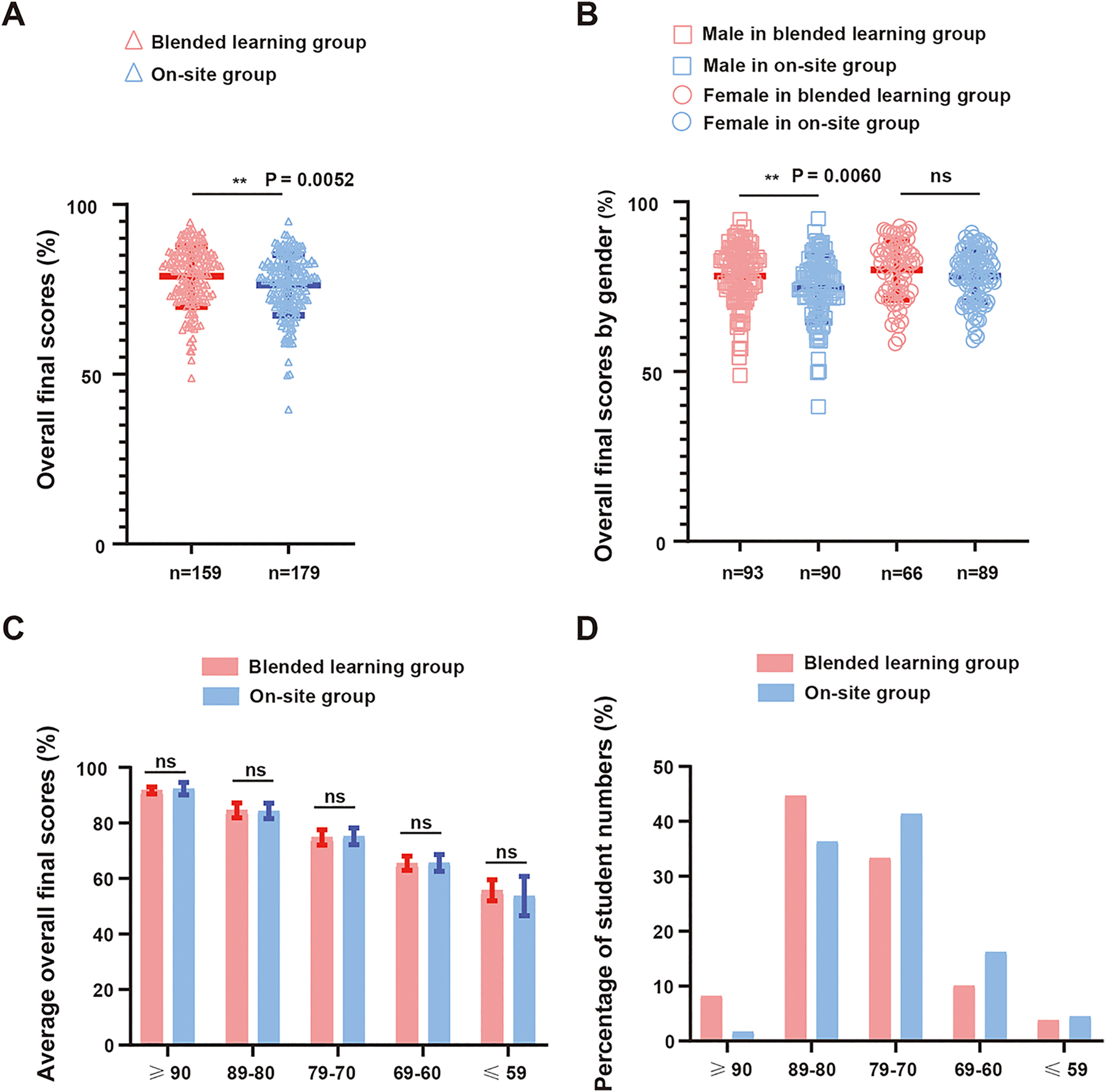
Overall final scores of students in the two teaching groups. (A) Dot plot of the students’ overall final scores. (B) Dot plot of students’ overall final scores categorized by gender within each group. (C and D) Bar chart of students’ average overall final scores categorized by score range (C), and student percentages grouped by overall final score intervals (D). Excellent, ≥90; very good, 80–89; good, 70–79; satisfactory, 60–69; failed, ≤59.
Of note, the scores of the post-lecture quizzes were similar between the two groups (Figure 3A), regardless of gender (Figure 3B). Further analysis of the distribution of the post-lecture quiz scores in different score sections revealed that the average post-lecture quiz scores were comparable between the two groups (Figure 3C). Surprisingly, the percentage of students in “excellent” (67.92 % vs. 79.33 %) section was lower in the blended learning group than in the on-site learning group (Figure 3D). However, the percentages of students in the “very good” (25.79 % vs. 17.88 %) and “good” (3.77 % vs. 0.56 %) sections were still higher in the blended learning group than those in the on-site group (Figure 3D). This indicates that online initiative learning elicits an effect similar to that of traditional methods with respect to knowledge acquisition.
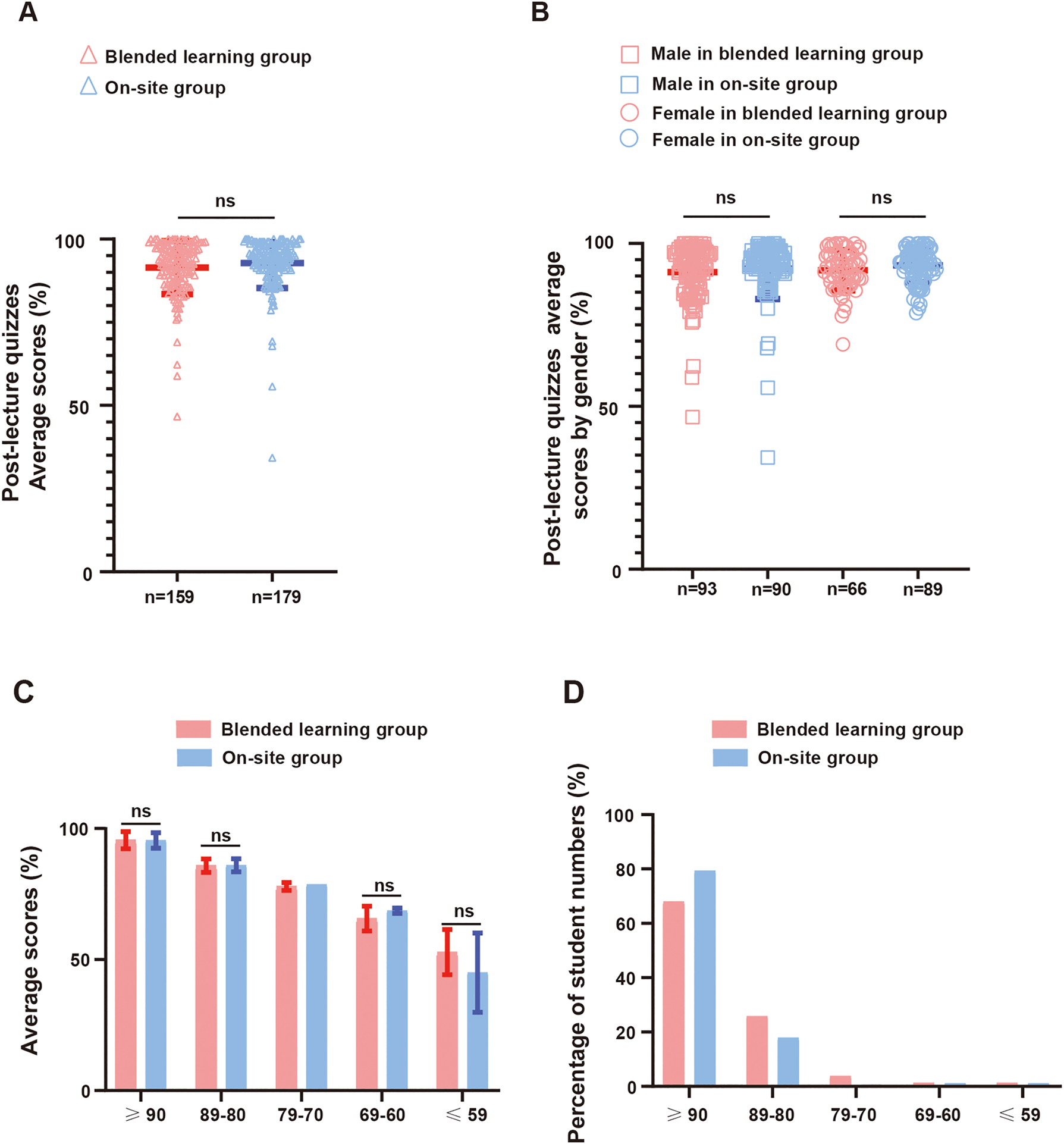
Students’ post-lecture quiz scores in the two teaching groups. (A) Dot plot of students’ post-lecture quiz scores. (B) Dot plot of students’ post-lecture quiz scores categorized by gender within each group. (C and D) Bar chart of students’ average post-lecture quiz scores categorized by score range (C), and student numbers grouped by post-lecture quiz score intervals (D). Excellent, ≥90; very good, 80–89; good, 70–79; satisfactory, 60–69; failed, ≤59.
Beyond knowledge transmission, “Quality Education” for Students is more important, which can be partially reflected in CBL and karyotyping. However, in the context of CBL scores, it was surprising to note that the on-site group outperformed the blended learning group, achieving significantly higher scores [(88.67±2.67) vs. (88.05±1.56)], albeit by a narrow margin (Figure 4A). Specifically, a significant difference existed in female students between the two groups, but not in male students (Figure 4B). Further analysis of the distribution of CBL scores in different score sections revealed that the average CBL score in the “excellent” section [(90.10±0.00) vs. (91.18±1.14)] was higher in the on-site group than in the blended learning group and comparable in the “very good” section (Figure 4C). In addition, the percentage of students in “excellent” (10.69 % vs. 30.73 %) section was higher in the on-site group, but that in the “very good” section (89.31 % vs. 67.04 %), including the majority of students, was higher in the blended learning group (Figure 4D). In addition, 2.23 % of the students in the on-site group were in the “good” section.
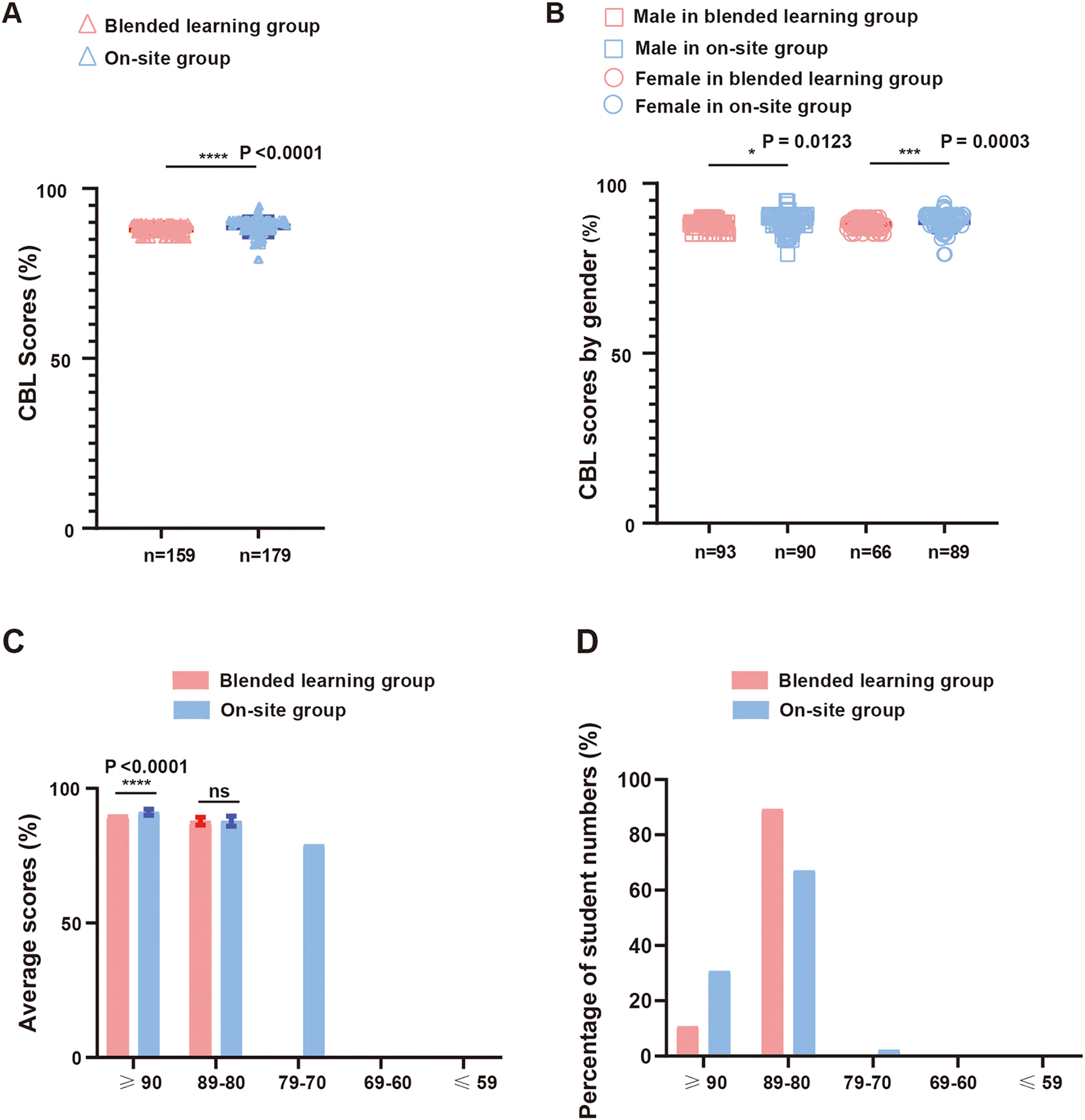
Case-based learning (CBL) scores of students in the two groups. (A) Dot plot of students’ CBL scores. (B) Dot plot of students’ CBL scores categorized by gender within each group. (C and D) Bar chart of students’ average CBL scores categorized by score range (C), and student numbers grouped by CBL score intervals (D). Excellent, ≥90; very good, 80–89; good, 70–79; satisfactory, 60–69; failed, ≤59.
With respect to karyotyping, a slight increase in scores was observed in the blended learning group compared to the traditional on-site group, but the difference was not significant (Figure 5A). This pattern was consistently observed in both male and female students (Figure 5B). Further analysis on the distribution of students in different score sections revealed that the average karyotyping score is higher at the “excellent” section [(98.86±1.92) vs. (94.77±3.05)], but is lower at the “very good” section [(85.75±2.87) vs. (87.64±1.44)] in the blended learning group than the on-site group (Figure 5C). In addition, the percentage of students was higher in the “excellent” section (85.53 % vs. 81.56 %), including the majority of students, but lower in the “very good” section (5.03 % vs. 10.61 %), including only a small population, in the blended learning group than in the on-site group (Figure 5D).
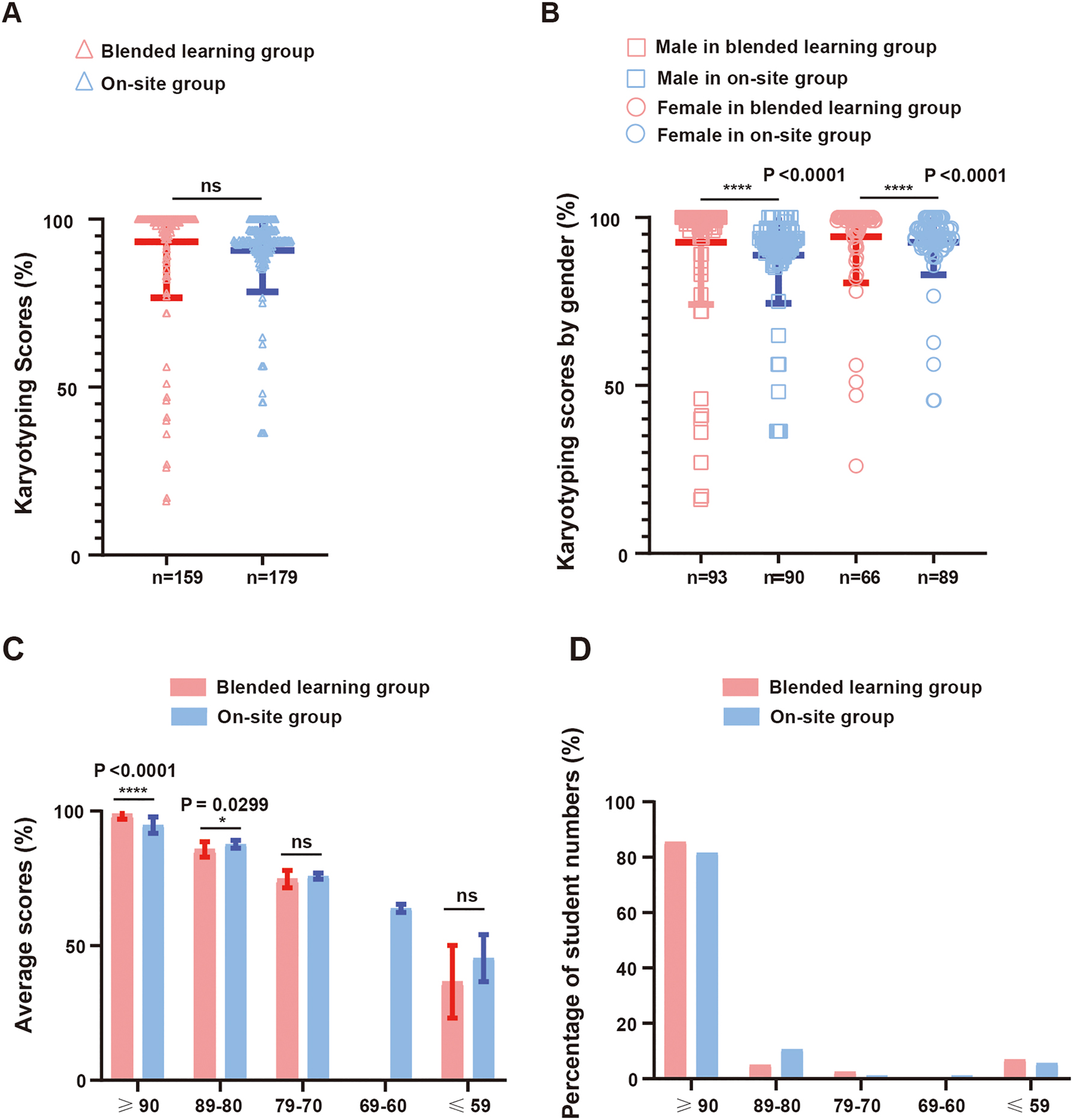
Karyotyping scores of students in the two groups. (A) Dot plot of students’ karyotyping scores. (B) Dot plot of students’ karyotyping scores categorized by gender within each group. (C and D) Bar chart of students’ average karyotyping scores categorized by score range (C), and student numbers grouped by karyotyping score intervals (D). Excellent, ≥90; very good, 80–89; good, 70–79; satisfactory, 60–69; failed, ≤59.
Compared to the traditional on-site group, the students in the blended learning group achieved higher examination scores, a comparable grade at the knowledge acquisition level, slight variation at the higher levels of cognitive processes from application to evaluation, and higher scores regarding the overall final grade.
Students’ satisfaction
To assess the effectiveness of the teaching methods, a questionnaire was administered following the completion of whole “Medical Genetics and Embryonic Development” course, in which we asked students about their satisfaction with the blended learning method. As shown in Figure 6A, the percentage of students’ choice of “very satisfied” was slightly higher in the on-site group in terms of overall course satisfaction. Regarding the blended learning curriculum itself, approximately 92 % of the students were satisfied with it (Figure 6B).
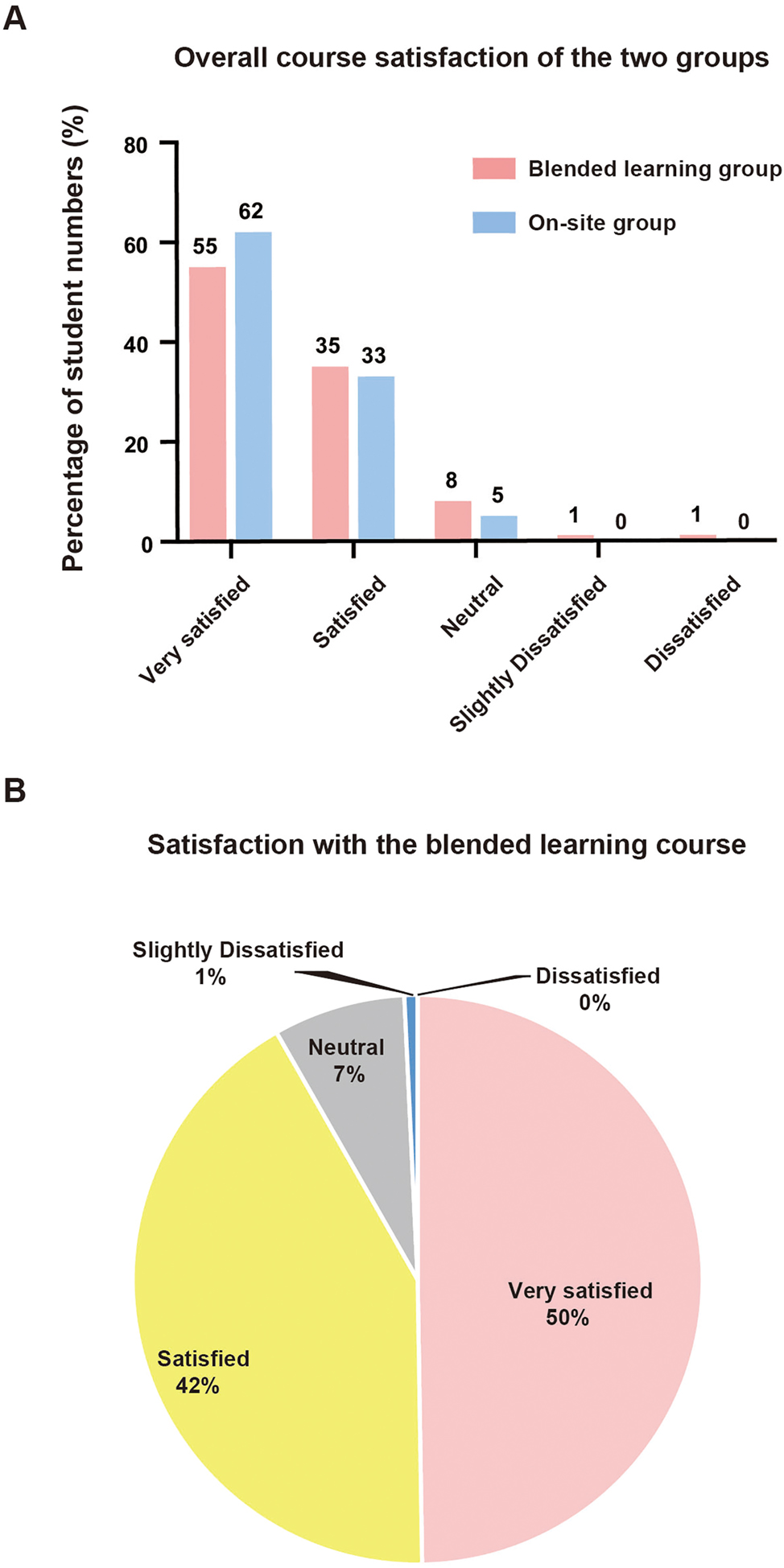
Students’ evaluation of the two teaching methods. (A) Students’ evaluation of blended learning and traditional on-site learning calculated by student numbers of the two teaching groups (B) students’ evaluation of blended learning calculated by the percentage of students in the blended learning group.
Discussion
This study provides robust evidence highlighting the effectiveness of blended learning in the context of “Medical Genetics and Embryonic Development” among undergraduate medical students. Notably, the students in the blended learning group earned higher overall final grades than those in the traditional on-site learning group, indicating the advantages of the blended learning method. However, in terms of knowledge acquisition, the performance of students in both groups was comparable, as evidenced by their scores on post-lecture quizzes. Interestingly, for higher-order learning skills such as karyotyping, students in the blended learning group outperformed those in the traditional group, particularly among scores in the excellent section (≥90). However, students in the traditional on-site learning group performed better in CBL scores. Finally, approximately 92 % of the students in the blended learning group were satisfied with this course.
Blended learning offers flexibility in terms of time and location, and has been found to improve engagement and learning outcomes, such as critical and creative abilities and academic success [11]. However, blended learning also has some disadvantages. For instance, designing and implementing a successful blended learning program can be complex and requires careful planning and organization [12]. In this study, we utilized the final grade as the primary endpoint to evaluate the effectiveness between blended learning and on-site learning, and found that blended learning led to better learning outcomes than traditional instruction, implying that undergraduate medical students can benefit from the blended learning method in the “Medical Genetics and Embryonic Development” curriculum, specifically at the overall quality level. In addition, traditional teaching has been recognized as a good approach for delivering knowledge to students in China. The absence of a traditional classroom setting can make it difficult for students to remain focused and motivated. Herein, by assessing the test scores, including post-lecture tests, the mid-term exam, and the final exam, we found that the higher, at least comparable, score levels existed between blended and on-site groups, suggesting that knowledge learning online achieved similar, or better, effects as traditional learning offline with respect to knowledge acquisition in our context. Furthermore, blended learning can improve the self-learning ability of medical students, which would favor their long-term development.
In the “Medical Genetics and Embryonic Development” course, both karyotyping and CBL actively engage students with real-world genetic diseases, effectively bridging the gap between theoretical knowledge and practical application. With the aim to assess the effect of blended learning on higher-order learning skills, we evaluated the performance of the students in the two groups with respect to karyotyping and CBL, respectively. Compared to team-based CBL, karyotyping acts as a better method for assessing personal higher-order learning skills. In the excellence section of karyotyping scores, the students in the blended group performed better in terms of both average scores and total student numbers, implying that blended learning can facilitate the study of karyotyping at the excellent level. However, students in the on-site group performed better than those in the blended learning group, albeit with a slight difference. One possible reason for this may be that blended learning reduced opportunities for face-to-face personal interaction with peers and instructors, potentially affecting the development of social skills and the spirit of cooperation in teamwork. In addition, the design and organization of the CBL may interfere with the effectiveness of the two groups. Some students thought that the current CBL puts too much attention on knowledge elaboration and presentation, and lacks training in critical thinking and problem-solving skills. Thus, the current CBL score cannot reflect the real discrepancy between the two groups with respect to higher-order learning skills. Next, we will optimize the CBL construction to match the objective, and augment the number of subjects to compare the performance of the two groups in CBL, which may provide a reliable conclusion on the effect of blended learning on CBL relative to traditional learning.
Overall, the blended learning model had better learning effectiveness than the traditional on-site teaching model, and the majority of students in the blended learning group were satisfied with this course. However, certain disadvantages also exist. The majority of students in the blended learning group perceived that online learning increased their study load. First, they should watch lecture videos online, which are longer than the scheduled course duration. Second, preview tasks and course assignments endowed a heavy load. The above elements may lead to dissatisfaction among certain students, as evidenced by the course satisfaction survey. A partial reason is that Chinese students are used to traditional on-site teaching models, in which they just need to listen to and remember the knowledge points required for later tests. In contrast, the blended learning model requires students to study by themselves first, which generates pressure for them. In our opinion, this kind of pressure can improve their self-learning ability, and our analysis also shows that they can handle this challenge well, although they do not like it too much.
Limitations and further improvements
It is important to note that the effectiveness of blended learning depends on the course design, online materials provided to the students, and integration of online and face-to-face components. Additionally, not all subjects or learning objectives could be well fitted to a blended learning method, and a particular subpopulation of students may require more structure or in-person interaction than this method offers. In addition, although the sample size of students is sufficient for statistical analysis, this is the first time that we apply a blended learning method in undergraduate students majoring in clinical medicine at Shanghai Jiao Tong University School of Medicine. Due to the relatively small sample size and single educational institution, this study has limitations. In the next few years, we will continuously implement the blended learning method in undergraduate students majoring in clinical medicine, collect more data for analysis, and provide experiences and measures to guide further teaching. Future research could explore the long-term impact of blended learning on students’ clinical competencies, specifically under “Medical Genetics and Embryonic Development” settings.
Conclusions
In the “Medical Genetics and Embryonic Development” course, blended learning is likely more effective than traditional on-site learning, and the students can benefit from the blended learning method to develop self-learning skills.
Funding source: 2023-2024 Academic Year Blended Course Program from Shanghai Jiao Tong University (Lei Huang)
Funding source: Shanghai Jiao Tong University School of Medicine (Bing Liao)
Award Identifier / Grant number: BMS202413
Acknowledgments
Our gratitude is extended to all instructors and student participants who contributed to the “Medical Genetics and Embryonic Development” curriculum.
-
Research ethics: The local Institutional Review Board deemed the study exempt from review.
-
Informed consent: Not applicable.
-
Author contributions: Study conception design: BL and LH; data collection, data analysis and interpretation of results: BL, SM, YN, HL, YX, SD, YC, XX, JW, MG, YT and LH; draft manuscript preparation: BL and SM; writing-review & editing: BL, SM and LH.
-
Use of Large Language Models, AI and Machine Learning Tools: None declared.
-
Conflict of interest: The authors declare that they have no conflicts of interest to report regarding the present study.
-
Research funding: This work was supported by Shanghai Jiao Tong University School of Medicine (BMS202413) to Bing Liao, and 2023–2024 Academic Year Blended Course Program from Shanghai Jiao Tong University to Lei Huang.
-
Data availability: All data/materials presented in this study are available from the corresponding author upon reasonable request.
References
1. Benbunan-Fich, R. Blended learning in higher education: framework, principles, and guidelines. Acad Manage Learn Educ 2008;7:135–7. https://doi.org/10.5465/amle.7.1.31413871b.Search in Google Scholar
2. Medina, LC. Blended learning: deficits and prospects in higher education. Australas J Educ Technol 2018;34:42–56. https://doi.org/10.14742/ajet.3100.Search in Google Scholar
3. Kerzic, D, Tomazevic, N, Aristovnik, A, Umek, L. Exploring critical factors of the perceived usefulness of blended learning for higher education students. PLoS One 2019;14:e0223767. https://doi.org/10.1371/journal.pone.0223767.Search in Google Scholar PubMed PubMed Central
4. Herbert, C, Velan, GM, Pryor, WM, Kumar, RK. A model for the use of blended learning in large group teaching sessions. BMC Med Educ 2017;17:197. https://doi.org/10.1186/s12909-017-1057-2.Search in Google Scholar PubMed PubMed Central
5. Ilic, D, Hart, W, Fiddes, P, Misso, M, Villanueva, E. Adopting a blended learning approach to teaching evidence based medicine: a mixed methods study. BMC Med Educ 2013;13:169. https://doi.org/10.1186/1472-6920-13-169.Search in Google Scholar PubMed PubMed Central
6. Vallée, A, Blacher, J, Cariou, A, Sorbets, E. Blended learning compared to traditional learning in medical education: systematic review and meta-analysis. J Med Internet Res 2020;22:e16504. https://doi.org/10.2196/16504.Search in Google Scholar PubMed PubMed Central
7. Liu, Q, Peng, WJ, Zhang, F, Hu, R, Li, YX, Yan, WR. The effectiveness of blended learning in health professions: systematic review and meta-analysis. J Med Internet Res 2016;18:e2. https://doi.org/10.2196/jmir.4807.Search in Google Scholar PubMed PubMed Central
8. Chen, J, Zhou, JH, Wang, Y, Qi, GY, Xia, CB, Mo, G, et al.. Blended learning in basic medical laboratory courses improves medical students’ abilities in self-learning, understanding, and problem solving. Adv Physiol Educ 2020;44:9–14. https://doi.org/10.1152/advan.00076.2019.Search in Google Scholar PubMed
9. Rowe, M, Frantz, J, Bozalek, V. The role of blended learning in the clinical education of healthcare students: a systematic review. Med Teach 2012;34:E216–21. https://doi.org/10.3109/0142159x.2012.642831.Search in Google Scholar
10. Kiviniemi, MT. Effects of a blended learning approach on student outcomes in a graduate-level public health course. BMC Med Educ 2014;14:47. https://doi.org/10.1186/1472-6920-14-47.Search in Google Scholar PubMed PubMed Central
11. Can, HC, Zorba, E, Isim, AT. The effect of blended learning on 21st-Century skills and academic success in education of physical education teachers: a mixed method research. Teach Teach Educ 2024;145:104614. https://doi.org/10.1016/j.tate.2024.104614.Search in Google Scholar
12. Nazarenko, AL. Blended learning vs traditional learning: what works? (A case study research). Procedia Soc Behav 2015;200:77–82. https://doi.org/10.1016/j.sbspro.2015.08.018.Search in Google Scholar
© 2024 the author(s), published by De Gruyter on behalf of the Shanghai Jiao Tong University and the Shanghai Jiao Tong University School of Medicine
This work is licensed under the Creative Commons Attribution 4.0 International License.
Articles in the same Issue
- Frontmatter
- Editorial
- Evolving landscapes in global medical education: navigating challenges and embracing innovation
- Review Articles
- Embarking on the era in new medicine: reshaping the systems of medical education and knowledge
- Aligning the education of medical students to healthcare in the UK
- Characteristics and considerations of French medical education
- Research Articles
- “Global challenge program” projects themed on preventing zoonosis: developing One Health core competences in medical students at SJTU
- Innovative exploration of designing the ‘Host Defense and Immunology’ course based on the concept of seamless learning
- Comparing the effects of blended learning and traditional instruction on “Medical Genetics and Embryonic Development” in undergraduate medical students: a randomized controlled trial
- The application of the “PICO” teaching model in clinical research course for medical students
- Factors bridging medical graduate students’ training and future academic achievements of dermatologists in China
- The teaching design and implementation of “Helicobacter pylori” in medical microbiology
Articles in the same Issue
- Frontmatter
- Editorial
- Evolving landscapes in global medical education: navigating challenges and embracing innovation
- Review Articles
- Embarking on the era in new medicine: reshaping the systems of medical education and knowledge
- Aligning the education of medical students to healthcare in the UK
- Characteristics and considerations of French medical education
- Research Articles
- “Global challenge program” projects themed on preventing zoonosis: developing One Health core competences in medical students at SJTU
- Innovative exploration of designing the ‘Host Defense and Immunology’ course based on the concept of seamless learning
- Comparing the effects of blended learning and traditional instruction on “Medical Genetics and Embryonic Development” in undergraduate medical students: a randomized controlled trial
- The application of the “PICO” teaching model in clinical research course for medical students
- Factors bridging medical graduate students’ training and future academic achievements of dermatologists in China
- The teaching design and implementation of “Helicobacter pylori” in medical microbiology

